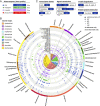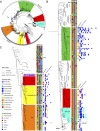Diel transcriptional oscillations of light-sensitive regulatory elements in open-ocean eukaryotic plankton communities
- PMID: 33547239
- PMCID: PMC8017926
- DOI: 10.1073/pnas.2011038118
Diel transcriptional oscillations of light-sensitive regulatory elements in open-ocean eukaryotic plankton communities
Abstract
The 24-h cycle of light and darkness governs daily rhythms of complex behaviors across all domains of life. Intracellular photoreceptors sense specific wavelengths of light that can reset the internal circadian clock and/or elicit distinct phenotypic responses. In the surface ocean, microbial communities additionally modulate nonrhythmic changes in light quality and quantity as they are mixed to different depths. Here, we show that eukaryotic plankton in the North Pacific Subtropical Gyre transcribe genes encoding light-sensitive proteins that may serve as light-activated transcription factors, elicit light-driven electrical/chemical cascades, or initiate secondary messenger-signaling cascades. Overall, the protistan community relies on blue light-sensitive photoreceptors of the cryptochrome/photolyase family, and proteins containing the Light-Oxygen-Voltage (LOV) domain. The greatest diversification occurred within Haptophyta and photosynthetic stramenopiles where the LOV domain was combined with different DNA-binding domains and secondary signal-transduction motifs. Flagellated protists utilize green-light sensory rhodopsins and blue-light helmchromes, potentially underlying phototactic/photophobic and other behaviors toward specific wavelengths of light. Photoreceptors such as phytochromes appear to play minor roles in the North Pacific Subtropical Gyre. Transcript abundance of environmental light-sensitive protein-encoding genes that display diel patterns are found to primarily peak at dawn. The exceptions are the LOV-domain transcription factors with peaks in transcript abundances at different times and putative phototaxis photoreceptors transcribed throughout the day. Together, these data illustrate the diversity of light-sensitive proteins that may allow disparate groups of protists to respond to light and potentially synchronize patterns of growth, division, and mortality within the dynamic ocean environment.
Keywords: diel cycles; metatranscriptomics; microbial eukaryotes; oligotrophic gyre; photoreceptors.
Copyright © 2021 the Author(s). Published by PNAS.
Conflict of interest statement
The authors declare no competing interest.
Figures




Similar articles
-
Diel-Regulated Transcriptional Cascades of Microbial Eukaryotes in the North Pacific Subtropical Gyre.Front Microbiol. 2021 Sep 29;12:682651. doi: 10.3389/fmicb.2021.682651. eCollection 2021. Front Microbiol. 2021. PMID: 34659137 Free PMC article.
-
Insight into planktonic protistan and fungal communities across the nutrient-depleted environment of the South Pacific Subtropical Gyre.Microbiol Spectr. 2024 Mar 5;12(3):e0301623. doi: 10.1128/spectrum.03016-23. Epub 2024 Feb 9. Microbiol Spectr. 2024. PMID: 38334383 Free PMC article.
-
Combined pigment and metatranscriptomic analysis reveals highly synchronized diel patterns of phenotypic light response across domains in the open oligotrophic ocean.ISME J. 2021 Feb;15(2):520-533. doi: 10.1038/s41396-020-00793-x. Epub 2020 Oct 8. ISME J. 2021. PMID: 33033374 Free PMC article.
-
Light-Oxygen-Voltage (LOV)-sensing Domains: Activation Mechanism and Optogenetic Stimulation.J Mol Biol. 2024 Mar 1;436(5):168356. doi: 10.1016/j.jmb.2023.168356. Epub 2023 Nov 7. J Mol Biol. 2024. PMID: 37944792 Review.
-
Photoorientation in photosynthetic flagellates.Methods Mol Biol. 2009;571:51-65. doi: 10.1007/978-1-60761-198-1_3. Methods Mol Biol. 2009. PMID: 19763958 Review.
Cited by
-
Plastid-localized xanthorhodopsin increases diatom biomass and ecosystem productivity in iron-limited surface oceans.Nat Microbiol. 2023 Nov;8(11):2050-2066. doi: 10.1038/s41564-023-01498-5. Epub 2023 Oct 16. Nat Microbiol. 2023. PMID: 37845316 Free PMC article.
-
Cation and Anion Channelrhodopsins: Sequence Motifs and Taxonomic Distribution.mBio. 2021 Aug 31;12(4):e0165621. doi: 10.1128/mBio.01656-21. Epub 2021 Jul 20. mBio. 2021. PMID: 34281394 Free PMC article.
-
Anthropogenic iron alters the spring phytoplankton bloom in the North Pacific transition zone.Proc Natl Acad Sci U S A. 2025 Jun 10;122(23):e2418201122. doi: 10.1073/pnas.2418201122. Epub 2025 Jun 2. Proc Natl Acad Sci U S A. 2025. PMID: 40455985 Free PMC article.
-
The North Pacific Eukaryotic Gene Catalog of metatranscriptome assemblies and annotations.Sci Data. 2024 Oct 22;11(1):1161. doi: 10.1038/s41597-024-04005-5. Sci Data. 2024. PMID: 39438508 Free PMC article.
-
Community Assembly and Co-Occurrence Patterns of Microeukaryotes in Thermokarst Lakes of the Yellow River Source Area.Microorganisms. 2022 Feb 21;10(2):481. doi: 10.3390/microorganisms10020481. Microorganisms. 2022. PMID: 35208934 Free PMC article.
References
-
- Roenneberg T., Merrow M., Circadian clocks - The fall and rise of physiology. Nat. Rev. Mol. Cell Biol. 6, 965–971 (2005). - PubMed
-
- Wijnen H., Young M. W., Interplay of circadian clocks and metabolic rhythms. Annu. Rev. Genet. 40, 409–448 (2006). - PubMed
-
- Noordally Z. B., Millar A. J., Clocks in algae. Biochemistry 54, 171–183 (2015). - PubMed
-
- Somers D. E., Phytochromes and cryptochromes in the entrainment of the Arabidopsis circadian clock. Science 282, 1488–1490 (1998). - PubMed
-
- Cashmore A. R., Cryptochromes: Enabling plants and animals to determine circadian time. Cell 114, 537–543 (2003). - PubMed
Publication types
MeSH terms
Substances
LinkOut - more resources
Full Text Sources
Other Literature Sources

